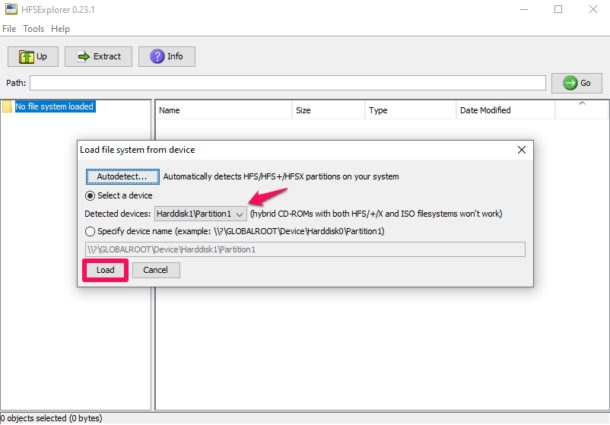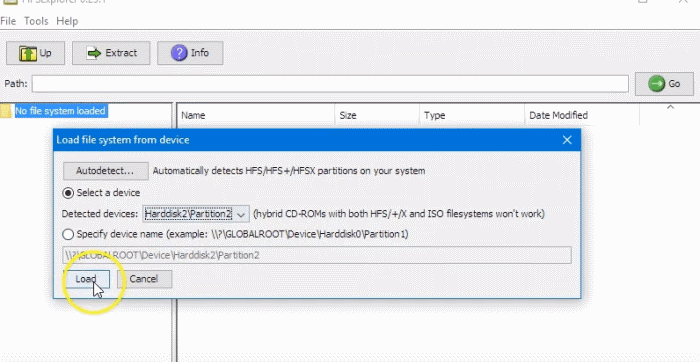

- #HFS FILE SYSTEM WONT DETECT DEVICE INSTALL#
- #HFS FILE SYSTEM WONT DETECT DEVICE UPDATE#
- #HFS FILE SYSTEM WONT DETECT DEVICE TV#
Version-Release number of selected component (if applicable):Īlways if there is either a FAT32 or HFS+ EFI System partition present prior to install.ġ. +++ This bug was initially created as a clone of Bug #1010495 +++ĭescription of problem: On Apple hardware with either an existing FAT32 EFI System partition, or an existing Fedora HFS+ EFI System partition, installer fails with an error message "you have not created a bootloader stage1 target device." See below for details.įor a UEFI installation, you must include an EFI System Partition on a GPT-formatted disk, mounted at /boot/efi." "No valid bootloader target device found. Below Error is observed despite creating a /boot/efi partition of type Linux HFS+ ESP. Create a / mount point from LVM of size 10000MiB.ĥ. Create a /boot/efi partition of size 200MiB with file system set toĤ. Select the disks and select custom partitioning.ģ. This problem has occured again in Fedora 21 beta so I am cloning this bug.Ģ. Storage.log from my reproduction with Final TC4Īnaconda logs for updates-1168118-tc2.imgĬustom part: cannot place bootloader stage1 partition on any disk but the first (UEFI, omapARM.) without messy workaro.
#HFS FILE SYSTEM WONT DETECT DEVICE UPDATE#
It shouldn’t be too much longer, but Apple is taking on a big task to carefully and silently update millions of iOS devices’ file systems so things will take a little longer than from my reproduction with Final TC4
#HFS FILE SYSTEM WONT DETECT DEVICE INSTALL#
What you might notice when you install iOS 10.3 is that it takes longer to install. It will help lay some of the foundations for Apple to switch fully over to 64-bit apps only on iOS, something that many believe will happen with iOS 11. Other than a tiny boost to storage, it’s unlikely you’ll see any benefits from this new file system on an iPad or iPhone just yet. Beta testers of iOS 10.3 reported seeing more storage available after the update, primarily due to the way APFS calculates available data. Most iPhone and iPad users won’t notice a difference after today’s iOS 10.3 update, but there could be a boost to storage levels for some. Apple demonstrated this during WWDC last year with a Mac, showing how APFS saved time on a simple file copy compared to HFS+. It’s also engineered with encryption as a primary feature, and even supports features like snapshots so restoring files on a Mac or even an iOS device might get a lot easier in the future.ĪPFS is designed for Apple's modern devicesĪs APFS is designed to be low latency, this should also improve read and write speeds on iOS or Mac devices. Apple’s new APFS is designed to scale across these new types of devices and take advantage of flash or SSD storage. Even its successor, HFS+, still doesn’t address the needs of these mobile devices enough.

It was originally designed for Macs with floppy or hard disks, and not for modern mobile devices with solid state storage.

#HFS FILE SYSTEM WONT DETECT DEVICE TV#
It’s a file system that was originally announced at WWDC last year, and it’s designed with the iPhone, iPad, Apple Watch, Mac, and Apple TV in mind.Īpple has been using its 31-year-old Hierarchical File System (HFS) for iOS devices so far.

Within iOS 10.3, Apple is moving supported devices to its new Apple File System (APFS). Most of the features in iOS 10.3 aren’t major, but Apple is actually undertaking a pretty huge shift for all iPad and iPhone users today. Apple’s iOS 10.3 is rolling out today, with a new find my AirPods option and CarPlay improvements.


 0 kommentar(er)
0 kommentar(er)
